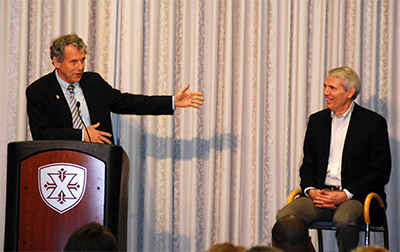Collaborative seeks innovative ways to advocate for children of addicted parents
 Cincinnati Children’s, in partnership with the Children of Addicted Parents (CAP) collaborative, sponsored an all-day conference on November 1 at Xavier University’s Cintas Center. The conference attracted 650 care providers from a variety of disciplines and featured national and local experts speaking about the impact of the heroin epidemic on children.
Cincinnati Children’s, in partnership with the Children of Addicted Parents (CAP) collaborative, sponsored an all-day conference on November 1 at Xavier University’s Cintas Center. The conference attracted 650 care providers from a variety of disciplines and featured national and local experts speaking about the impact of the heroin epidemic on children.
Kathy Wedig-Stevie, MD, a Cincinnati Children’s neonatologist who attends in the neonatal abstinence clinic (NAS) of the medical center’s Neonatal High Risk follow-up clinic and at the Good Samaritan Hospital NICU and High Risk Clinic, led the planning for the conference. She was thrilled with the interest and participation level at the event.
“People were engaged. They asked good questions and wanted to solve the problem. They stayed until the end,” she says. “Local agencies staffed about 35 resource booths. It was intense, but people were hungry for information.”
The CAP collaborative is a partnership of area organizations devoted to childhood development and strengthening families. These include GLAD House; Help Me Grow; Every Child Succeeds; Cincinnati Children’s Therapeutic Interagency Preschool (TIP) program; St. Aloysius Orphanage; Lighthouse Youth Services; Sojourner Recovery Services and Cincinnati Public Schools.
The collaborative began a little over 3 years ago with Bea Lampkin, MD, a former director of Cincinnati Children’s Hematology/Oncology and founder of GLAD House, which serves children of addicted parents, ages 5 through 12. Lampkin had come to realize that these children needed earlier intervention.
Since the group’s first meeting in January 2013, they’ve made great headway in identifying and reaching out to mothers who are addicted and their children. But the problem continues to grow.
Says Wedig-Stevie, “We need to look at addiction as a medical issue, not a bad choice. That’s a tough perception to change. Addicted people aren’t easy to be around. But every addict has a family that’s being affected, and if we’re going to break the cycle, we need to start investing in helping the children of those addicts.”
The Perinatal Center’s data show that four out of every 100 babies born in our region are exposed to opioids in utero. Roughly 1.3 of every 100 babies develop Neonatal Abstinence Syndrome (NAS), which requires treatment and a hospital stay of 16 days – at an average cost of $60,000. The normal stay for a healthy baby is 1.5 days.
Of those opioid-exposed babies, 2.4 of every 100 do not develop NAS but are still at risk of developmental issues related to their exposure.
“This is the hardest group of babies to follow,” says Wedig-Stevie. “My concern is that these children will go into the school system with their delays and behavioral issues and be labeled ‘bad’ kids. We need to identify these kids and connect them with the right services so they can have the best life possible.”
Conference fills a need
At the November conference, participants were asked specific questions about what direction the community should take in tackling opioid addiction and how they want to be involved. Wedig and the conference facilitator are compiling a report, which will be discussed at a special meeting on January 12 to decide next steps.
Meanwhile, if you have concerns about patients who may have been exposed to opioids, you can refer them to the NAS clinic at Cincinnati Children’s by calling 513-636-3882. The clinic sees children up to age 2.
A transcript of the CAP conference will be available on the Cincinnati Children’s CME website in January at https://www.cincinnatichildrens.org/professional/continuing-education.
For more information about opioid exposure in children or to find out how you can help, contact Kathy Wedig-Stevie at 513-872-2748 or kathy.wedig@cchmc.org.



